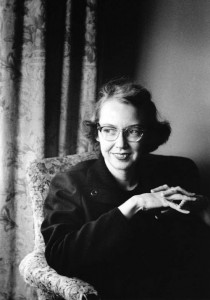 This is a masterpiece of American literature that will present difficulties for a Canadian reader. This was Flannery O’Connor’s first novel, written in 1949. O’Connor (1925–1964) was a native of central Georgia, and the old segregated American South that she writes about more than confirms the adage that “the past is a foreign country.” The world of Wise Blood is closer to another planet than a mere foreign country. Widely regarded as the heir to William Faulkner, literary convention has placed O’Connor in the annoyingly patronizing academic compartments of “Southern Gothic” and “Regional Fiction”. (If you write in New York, of course, that isn’t “regional”). Much is made of the “grotesque” elements in her fiction. But she was not much pleased with that kind of peg-boarding. “Anything that comes out of the South is going to be called grotesque by the northern reader, unless it is grotesque, in which case it is going to be called realistic,” she once remarked.
This is a masterpiece of American literature that will present difficulties for a Canadian reader. This was Flannery O’Connor’s first novel, written in 1949. O’Connor (1925–1964) was a native of central Georgia, and the old segregated American South that she writes about more than confirms the adage that “the past is a foreign country.” The world of Wise Blood is closer to another planet than a mere foreign country. Widely regarded as the heir to William Faulkner, literary convention has placed O’Connor in the annoyingly patronizing academic compartments of “Southern Gothic” and “Regional Fiction”. (If you write in New York, of course, that isn’t “regional”). Much is made of the “grotesque” elements in her fiction. But she was not much pleased with that kind of peg-boarding. “Anything that comes out of the South is going to be called grotesque by the northern reader, unless it is grotesque, in which case it is going to be called realistic,” she once remarked.
O’Connor was a Catholic, something which is pretty normal here in Canada, where it doesn’t involve much in the way of metaphysical or psychological complexity. But in Georgia, it makes one an outsider, and philosopher. O’Connor was fascinated by faith, apostasy, sin and redemption, and in the religiously supercharged world of the South, and especially the region where the Mountain culture interacts with the Deep South, there was plenty of material to chew on. Wise Blood tells the tale of Hazel Mote, traumatized son of a preacher who hates religious faith, but finds himself involved in every kind of religious experience. He is a virtual catalog of heresies and bizarre religious practices, while he tries to avoid belief. He is surrounded by an assortment of odd characters, each one driven by some equally peculiar belief. One character ends up worshiping a mummy in a museum. It all does seem grotesque, a kind of surrealistic fantasy. But the irony is that nothing happens in the book, and no character is represented, that has not existed in real life.
That is the real power of the book. Everything in it is relentlessly faithful to reality. It’s written with incredible control, precision and economy (it is really a novella, rather than a novel). Not a word is wasted, not a word is wrong, not a word is out of place. Dialect and idiolect are rendered with absolute perfection. Sometimes a single, short sentence will create a crystal clear visual image in the reader’s head. The prose sings,
I could not come from a more different cultural background, and my interests and preoccupations could not be more different than O’Connor’s, but this book still held me in complete absorption. What must it do for someone for whom it’s closer to the bone? I would love to sit down and talk over this book with my old friend William Breiding, who must surely have read it. William? Send me your thoughts on this one.
0 Comments.